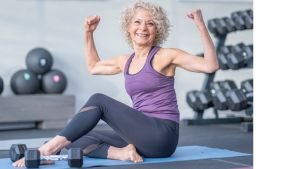Time to Get Moving
If you’re sitting in a comfortable La-Z-Boy recliner with your feet propped up and thinking about taking a nap, it’s time to stand up and start moving. (There is a time for elevating the feet, but not in today’s post.) It may be time to consider a workout routine for older adults.
Current research supports an active workout routine for older adults. The benefits of exercising later in life are backed by thousands of pages of scientific study. It makes sense—if you stop moving, you’ll stop being able to move. Here are twelve reasons to incorporate a regular exercise routine into your schedule.
1) Less Pain
Strengthening the muscles around joints helps lessen osteoarthritis pain. Simple stretching exercises, such as arm circles and shoulder rolls, increase the range of motion and decrease joint stiffness.
2) Stronger Bones
It’s easy to envision changes in the structure of muscles and fat cells due to a workout routine. However, we often see bones as dead weight that prevent us from looking like Gumby. In reality, bones are living tissues. They become weaker and more fragile as we age. A regular workout routine for older adults, along with sufficient calcium and vitamin D, can strengthen bones, making them denser and less likely to break, fracture, or shatter after a fall or injury.

3) Sleep Better
Parents of toddlers have understood for centuries that keeping small children busy throughout the day results in better sleep at night. The same applies to older adults. Researchers have found that morning workouts, particularly in women, tend to burn off weight more effectively because the calories burned do not come from recent food intake. Afternoon and evening workouts help lower blood pressure and reset the body’s circadian rhythm, promoting a restful night’s sleep.
4) Reduce the Risks of Alzheimer’s Disease
According to Stanford Lifestyle Medicine, “One of the most well-studied activities that enhance our cognition is physical exercise.” Studies show that workout routines for older adults can reduce the risk of Alzheimer’s by up to 45%. There are various scientific terms like cAMP and BDFN that explain this. I don’t fully understand cAMP/BDFN, but I know that working the body helps keep the mind functioning properly.
5) Maintain Flexibility
Think about it – do you really want to call for a tractor and chain to help lift you off the floor after the grandkids leave? Exercise can help you maintain a full range of motion, reduce joint stiffness, and avoid embarrassing “I’m stuck down here” cries for help.
6) Lower Risks of Serious Diseases
Regular exercise strengthens the heart to help prevent cardiovascular diseases. Aerobic workouts burn calories that aid in weight loss to fight against diabetes. The American Cancer Society says that exercise has been linked to lower cancer risks for thirteen types of cancer, including breast, colon, and lung cancer.
7) Reduce Weight
There’s no way around this: Burn more calories than you consume. Muscle mass burns slightly more calories at rest than fat cells. Building muscle can be challenging as we age. I struggled for many years to regain the muscle lost due to hormonal changes until a bodybuilder at my gym offered me two helpful pieces of advice: Increase protein intake after a workout, and lift weights that feel heavier than what is comfortable. With these two changes, I’ve seen better results in restoring muscle strength.
8) Improve Balance
Many older adults can no longer live independently due to poor balance and frequent falls. Incorporate balance and flexibility exercises into your routine. Hold onto the edge of a chair and balance on one foot at a time. Practice standing up and sitting down on a chair without holding onto anything.
9) Improve the Immune System
According to the Journal of Sport and Health Science, “Habitual exercise improves immune regulation, delaying the onset of age-related dysfunction.” Exercise combats anti-inflammatory processes, enhances overall gut health, and strengthens disease-fighting antioxidants in the body.

10) Increase Energy
You might think a workout would drain your energy levels. Surprisingly, exercise generates powerful mitochondria, converting food and oxygen into fuel. It also improves circulation, allowing oxygen to work more efficiently.
11) Bolsters a Positive Outlook
A regular workout routine for older adults helps maintain a more positive mood by reducing anxiety, depression, tension, and stress. Exercise releases chemicals called endorphins that block pain and create feelings of pleasure, along with norepinephrine (one of the regulators of the fight or flight response), BDNF, serotonin, and dopamine, the reward chemical. Regular exercise also lowers cortisol and adrenaline, both of which contribute to stress.
12) Improves cholesterol levels
A 2024 study found that the more active you are, the more saturated fat your muscles utilize. Exercise also prompts the body to transport harmful cholesterol to the liver for removal, leading to an increase in good cholesterol and a decrease in bad cholesterol. In addition to improving your health, adjusting cholesterol levels will make your doctor very happy.
Before starting any workout routine for older adults, it’s wise to talk to your doctor. Understand your body’s limits to prevent injury and overexertion.
Does this sound like a lot of hard work? In the next newsletter, I’ll share ways to make exercise fun.
So, are you still in the Lazy-E-Boy? Thanks for reading to the end, but put your device down. Stand up. There you go. Get moving!
More about Growing Older
Resources
National Council on Aging: The Life-Changing Benefits of Exercise After 60
John Hopkins Medicine: Exercise and the Aging Person
National Institute on Aging: Health Benefits of Exercise and Physical Activity
Stanford Lifestyle Medicine: How Exercise Reduces Risk of Alzheimer's Disease
Ortho Info: Exercise and Bone Health
VIP Care: When Is the Proper Time to Exercise For Older Adults?
American Cancer Society: Exercise Linked With Lower Risk of 13 Types of Cancer
Harvard Health Publishing: Does Exercise Really Boost Energy Levels?
British Heart Foundation: Can Exercise Help Lower Cholesterol?



